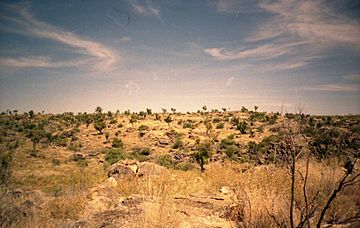Australian Fossil Mammal Sites (Riversleigh) facts for kids
| UNESCO World Heritage Site | |
|---|---|
 |
|
| Location | Gregory, Queensland, Australia |
| Part of | Australian Fossil Mammal Sites (Riversleigh / Naracoorte) |
| Criteria | Natural: (viii), (ix) |
| Inscription | 1994 (18th Session) |
| Area | 10,029 ha (38.72 sq mi) |
Riversleigh is an amazing place in north-west Queensland, Australia. It is one of the Australian Fossil Mammal Sites. UNESCO has listed it as a World Heritage Site. This means it is a very important place for everyone in the world to protect. The other site like it is the Naracoorte Caves National Park in South Australia. Riversleigh is part of the Boodjamulla National Park. The area where fossils are found is about 100 square kilometers.
The fossils found here are the remains of ancient mammals, birds, and reptiles. They lived during the Oligocene and Miocene epochs. These are periods of time millions of years ago. Riversleigh became a World Heritage site in 1994. The fossils at Riversleigh are very special. They are found in soft freshwater limestone. This means they have not been squashed flat. So, the animal remains still look three-dimensional.
Contents
Discovering Ancient Life at Riversleigh
Fossils at Riversleigh are found in limestone near ancient freshwater pools. They are also found in caves. These fossils show how the ecosystem changed over time. It went from a rich rainforest to a drier, semi-arid grassland.
Riversleigh is the richest place in the world for bat fossils. Scientists have found 35 different kinds of ancient bats here. They also found a skull of a 15-million-year-old monotreme. This animal is called Obdurodon dicksoni. It was a giant platypus-like creature. This fossil helps us understand how Australian animals like the platypus evolved.
Scientists have also found fossil ancestors of the extinct thylacine (Tasmanian tiger). In 1993, Nimbadon skulls were found in a new cave. Nimbadon was a sheep-like marsupial. Scientists think it first appeared about 15 million years ago. It died out around 12 million years ago. This might have happened because of climate change. Other fossils show how the koala changed. This happened as Australia's rainforests became drier eucalypt forests.
Amazing Fossils Found Here
Here are some of the cool fossils found at Riversleigh:
- Ekaltadeta: A meat-eating rat-kangaroo.
- Burramys: The Mountain Pygmy Possum.
- Nimbacinus: An ancestor of the Thylacine.
- Obdurodon: A giant platypus.
- Yarala: A tube-nosed bandicoot.
- Yalkaparidon: A very strange marsupial.
- Wakaleo: A marsupial lion.
- Priscileo: Another marsupial lion.
- Nimiokoala: An ancient koala.
- Nimbadon: A sheep-like marsupial.
- Pengana: A flexible-footed bird of prey.
- Menura tyawanoides: A prehistoric lyrebird.
- The first fossil record of the Orthonychidae (logrunner) bird family.
- Trilophosuchus: A tree-dwelling crocodile.
- Baru: The cleaver-headed crocodile.
- Yurlunggur and Wonambi: Extinct snakes (Madtsoiidae).
Images for kids
See also
 In Spanish: Riversleigh para niños
In Spanish: Riversleigh para niños


